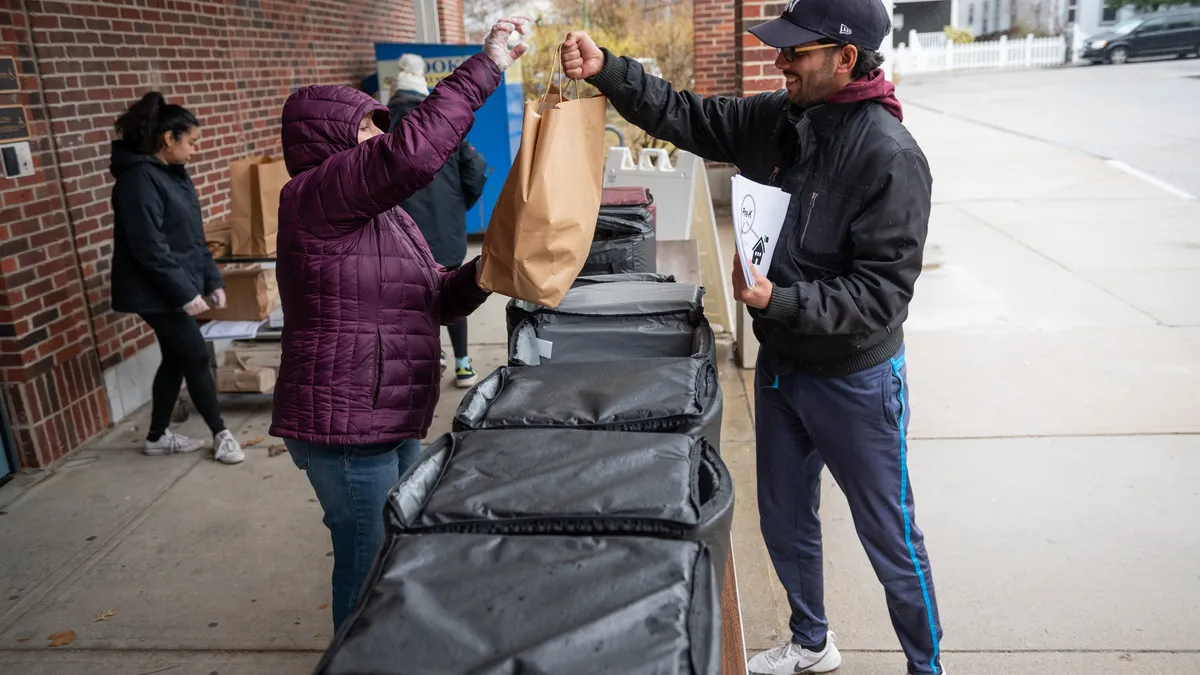UPDATE: Aug. 31, 2020: The U.S. Department of Agriculture announced the extension of summer meal program waivers until December 31, 2020. The decision, immediately applauded by the School Nutrition Association and districts, means schools will be able to provide meals to all children with added flexibilities until the end of the year. The agency maintains Congress did not authorize enough funding to provide waivers for 2020-21, but Secretary of Agriculture Sonny Perdue said it is extending the programs for "as long as we can, legally and financially."
The U.S. Department of Agriculture has extended a handful of meal waivers for the 2020-21 school year, but left out flexibilities for key programs many schools have depended on to distribute meals to students during the pandemic.
The Summer Food Service Program and Seamless Summer Option, combined with additional flexibilities, allowed almost any school to be an open meal site where families could pick up meals for children regardless of income status or the child's age.
But the programs are ending Sept. 30 — or earlier if a school district begins its fall term before that date. U.S. Secretary of Agriculture Sonny Perdue has pushed back on lawmakers' requests for extensions, contending further funding and authorization are needed.
"While we want to provide as much flexibility as local school districts need during this pandemic," Perdue wrote in a letter to Rep. Bobby Scott, D-VA, "the scope of this request is beyond what USDA currently has the authority to implement and would be closer to a universal school meals program which Congress has not authorized or funded."
Disagreement over authority and funding
The response was prompted by a request addressed to Perdue on Aug. 14 from Scott and Rep. Debbie Stabenow, D-Mich., who said the flexibilities were critical for food distribution and reduced the administrative burden on schools and school administrators.
Disagreeing with Perdue, Scott told Education Dive in a statement that Congress explicitly gave the USDA "broad authority" to make such waiver decisions, saying "there is no question" the department can do so through the next school year.
In a statement to Education Dive, Perdue said USDA had an agenda to issue "unprecedented waivers" for all children to receive nutritious meals, free of charge. But appropriations funded through the Coronavirus Aid, Relief, and Economic Security (CARES) Act planned for waivers through the end of June, he added.
"We have been and are continually calculating remaining appropriated funds to determine how far we may be able to provide waivers into the future," Perdue said.
Turning away children and families
Districts that have begun their school year can continue meal distribution through the standard National School Lunch and Breakfast (NSL and NSB) programs. Under those avenues, schools have to turn students or families away if they have not received and completed the proper paperwork, or do not come to their assigned grab-and-go location, according to Scott.
If families have students enrolled in different schools within a district, they'll have to pick up meals from separate locations, which can sometimes be far apart. With transportation an issue for some families, especially in low-income rural areas, this proved challenging in the spring and compelled principals and other district employees to deliver meals.
Families also won't be able to pick up meals for younger siblings if they are not enrolled in the district. This is a departure from meal distribution in the spring, when some meal sites chose to distribute to everyone who needed a meal.
This change is already playing out in districts. Virginia's Lynchburg City Schools, where Beth Morris, director of school nutrition for the district, has had to turn away students' younger siblings and homeschooled children. Inaction from the federal government, Morris said, has stalled her from meeting the needs of all local children since Lynchburg's school year began this week.
No 'fool-proof' solutions
In addition, schools will have to differentiate between students paying in full or receiving free or reduced-price lunches. According to the School Nutrition Association (SNA), the process of handling money and using a touch-pad system to check eligibility would put school nutrition staff at risk of contracting or spreading COVID-19.
Morris said many of her colleagues are struggling to devise a way to differentiate the categories of eligibility.
"To date, I don't know that there is one that is fool-proof," she said.
Requiring payment instead of offering free meals also means schools with curbside pickup locations will have to transport their transaction sites, which would require additional equipment or Wi-Fi. Instead, schools may opt to use paper rosters, which could slow the overall distribution process, the SNA said.
At the same time, the education organizations expect an influx of children unable to pay for meals who will depend on the NSL and NSB programs. Meeting meal requirements under those programs are more costly and also have lower rates of federal reimbursement than if schools could have continued the summer meal programs.
Meanwhile, the NSL and NSB programs are facing a "dire financial situation," SNA Director of Media Relations Diane Pratt-Heavner said. They depend on revenues from full-priced lunches, which disappeared while students were not paying for meals during closures, and schools with hybrid or distance learning this fall could see a continued decline in meal revenues.
Educators and organizations are now putting pressure on the USDA and congressional leaders to work together and allow extensions for the summer programs, which they say would be the most effective way to ensure meal distribution is carried out safely and consistently.





















